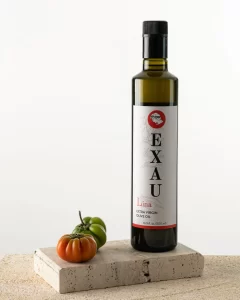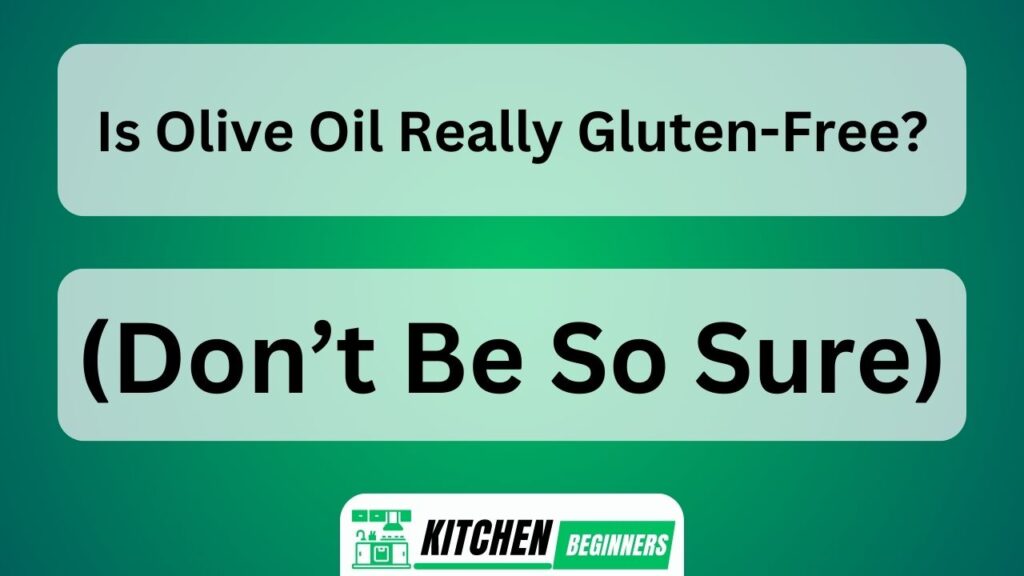Many people assume that olive oil is gluten-free, but is that really the case? In this informative article, we delve into the world of gluten and olive oil to uncover the truth.
From potential contamination sources to labeling standards and cross-contamination concerns in production, we leave no stone unturned. With the help of testing methods and accuracy, we provide evidence-based tips for choosing gluten-free olive oil.
Don’t be so sure, because the answer may surprise you.
Key Takeaways Is Olive Oil Really Gluten Free? Don’t Be So Sure
- Olive oil is considered gluten-free from a composition standpoint, but potential contamination sources during production can lead to trace amounts of gluten in olive oil.
- Cross-contamination can occur if olives are processed in facilities that handle gluten-containing products, posing a risk to individuals with gluten sensitivities or celiac disease.
- Cross-contamination risks should be considered when evaluating the gluten-free status of olive oil, and thorough cleaning of kitchen tools and surfaces is important to minimize the risk.
- While there is currently no specific certification for gluten-free olive oil, consumers should rely on labeling and testing practices of individual brands and choose certified gluten-free brands to ensure product safety.
The Basics of Gluten and Olive Oil
Gluten is a protein that is not naturally present in olive oil. Olive oil is derived from the pressing of olives, and gluten is found in grains such as wheat, barley, and rye. Therefore, from a composition standpoint, olive oil should be considered gluten-free.

However, the issue lies in the potential contamination sources during the production process. Cross-contamination can occur if the olives are processed in facilities that also handle gluten-containing products or if the equipment used is not properly cleaned. This can lead to trace amounts of gluten finding their way into the olive oil.
While these amounts may be minimal, they can still pose a risk to individuals with gluten sensitivities or celiac disease. Therefore, it is important for individuals with gluten intolerance to be aware of potential contamination sources when choosing olive oil.
Potential Contamination Sources
Cross-contamination risks and shared production facilities are important factors to consider when discussing potential contamination sources.

Cross-contamination can occur when allergens or gluten-containing products come into contact with gluten-free products, leading to unintended exposure.
Shared production facilities, where both gluten-free and gluten-containing products are made, increase the risk of cross-contamination and pose a challenge for individuals with gluten sensitivities or celiac disease.
It is crucial for manufacturers and consumers to be aware of these risks and take necessary precautions to minimize the chances of contamination.
Cross-Contamination Risks
When it comes to cross-contamination risks, you should be aware of potential sources of gluten in your kitchen. Even if you don’t intentionally use gluten-containing products, there may still be a risk of cross-contamination.

For example, using the same cutting board or utensils for both gluten-free and gluten-containing ingredients can lead to the transfer of gluten particles. Similarly, using a toaster that has been used for regular bread can contaminate gluten-free bread. It’s important to thoroughly clean all kitchen tools and surfaces to minimize the risk of cross-contamination.
However, even with these precautions, there is still a possibility of gluten contamination in products that are manufactured in shared production facilities. This is something to consider when evaluating the gluten-free status of olive oil or any other product.
Shared Production Facilities
Using shared production facilities can increase the risk of inadvertent gluten contamination in certain food products. This occurs when gluten-containing ingredients or products are processed in the same facility as gluten-free items, leading to cross-contamination. Here are three reasons why shared production facilities can pose a risk:

- Equipment: Shared facilities may use the same equipment to process both gluten-free and gluten-containing products. Even with thorough cleaning, it is challenging to completely eliminate gluten residue, increasing the chances of contamination.
- Airborne Particles: Gluten particles can become airborne during production and settle on surfaces throughout the facility. If not properly managed, these particles can contaminate gluten-free products.
- Handling Practices: In shared facilities, there is a higher likelihood of employees handling both gluten-free and gluten-containing items. If proper precautions are not followed, cross-contamination can occur through contact with hands, gloves, or utensils.
It is crucial for manufacturers to implement strict protocols and testing to minimize the risk of gluten contamination in shared production facilities.
Labeling and Certification Standards
Labeling and certification standards play a crucial role in determining the gluten-free status of olive oil. The Food and Drug Administration (FDA) has set guidelines for manufacturers to follow when labeling their products as gluten-free. According to these guidelines, a product can only be labeled as gluten-free if it contains less than 20 parts per million (ppm) of gluten.
However, there is currently no specific certification for gluten-free olive oil. This means that consumers must rely on the labeling and testing practices of individual brands. Some brands voluntarily test their products for gluten and certify them as gluten-free through third-party organizations.
It is important for consumers with gluten sensitivities or celiac disease to carefully read labels and choose brands that have been certified as gluten-free to ensure their olive oil is truly safe for consumption.
Cross-Contamination Concerns in Production
Labeling and certification standards play an important role in determining whether a product is gluten-free. However, it is also crucial to consider the potential for cross-contamination during production. Cross-contamination occurs when gluten-containing products come into contact with gluten-free ones, leading to the unintentional presence of gluten in the final product.
In the case of olive oil, cross-contamination can occur during the pressing and bottling processes. Here are three factors that contribute to the risk of cross-contamination in olive oil production:
- Shared equipment: If the same machinery is used to process both gluten-containing grains and olives, there is a high risk of cross-contamination.
- Storage and transportation: If olive oil is stored or transported in facilities or containers that have also been used for gluten-containing products, cross-contamination can occur.
- Supplier practices: If the olives used to make the oil are grown in close proximity to gluten-containing crops or if the processing facility is located near such crops, the risk of cross-contamination increases.
Considering these factors, it is important for individuals with gluten intolerance or celiac disease to exercise caution when consuming olive oil, even if it is labeled as gluten-free.
Gluten in Flavored Olive Oils
Potential cross-contamination risks, labeling, and ingredient transparency are important considerations when it comes to flavored olive oils and their gluten content.
Cross-contamination can occur during the production process, where traces of gluten may inadvertently end up in the final product.
Clear labeling and ingredient transparency help consumers make informed choices about the gluten content of flavored olive oils, allowing those with gluten sensitivities or allergies to avoid potential health risks.
Potential Cross-Contamination Risks
Despite manufacturers’ best efforts, there’s always a chance of cross-contamination risks in the production of olive oil. Olive oil is often produced in facilities that also handle other food products, which increases the possibility of cross-contamination.
Here are three potential sources of cross-contamination in olive oil production:
- Shared equipment: Facilities may use the same equipment for processing different products, such as nut oils or flavored oils, which could contain gluten or other allergens.
- Storage and transportation: Olive oil may be stored or transported in containers that have previously held products with gluten or other allergens, leading to potential cross-contamination.
- Cleaning procedures: Inadequate cleaning procedures can result in residual allergens from previous production runs being present in the equipment, leading to cross-contamination.
These cross-contamination risks highlight the importance of labeling and ingredient transparency in olive oil products to ensure the safety of individuals with gluten sensitivities or allergies.
Labeling and Ingredient Transparency
Make sure to check the ingredient list on the olive oil product to see if there are any potential allergens present. While olive oil is generally considered gluten-free, there are cases where cross-contamination can occur during processing or packaging. Consequently, it is crucial to read the labels and look for any allergen warnings or statements. Manufacturers are required to disclose the presence of common allergens, including gluten, on their ingredient lists. However, it is worth noting that some olive oil brands may not include detailed information about potential cross-contamination risks. To illustrate the importance of ingredient transparency, consider the following table:
| Brand | Ingredients | Potential Allergens |
|---|---|---|
| Brand A | Extra Virgin Olive Oil | None |
| Brand B | Olive Oil, Soybean Oil | Soybean Oil |
| Brand C | Olive Oil, Wheat Germ Oil | Wheat Germ Oil |
As we can see, Brand B contains soybean oil, which may be an allergen for some individuals. Brand C includes wheat germ oil, which contains gluten. This table highlights the need to thoroughly examine the ingredients to ensure gluten-free olive oil.
This emphasizes the significance of testing methods and accuracy in determining gluten content in olive oil.
Testing Methods and Accuracy
You might want to consider the testing methods and their accuracy when determining if olive oil is truly gluten-free. While manufacturers may claim their olive oil is gluten-free, it’s important to understand how they arrive at this conclusion. Here are three factors to consider:
- ELISA Testing: Enzyme-Linked Immunosorbent Assay (ELISA) is commonly used to test for gluten in food products. It detects gluten proteins by using specific antibodies. However, the accuracy of this method can vary, and it may not detect all forms of gluten.
- Cross-Contamination: Olive oil can become contaminated with gluten during production, processing, or packaging. Even if the olives themselves are gluten-free, there is a risk of cross-contamination if the equipment or facilities are not properly cleaned.
- Third-Party Certification: Look for olive oils that have been certified gluten-free by a reputable third-party organization. These certifications often involve rigorous testing and inspections to ensure the product meets gluten-free standards.
Considering these testing methods and potential sources of gluten contamination is crucial when determining the gluten-free status of olive oil. Now, let’s explore some tips for choosing gluten-free olive oil.
Tips for Choosing Gluten-Free Olive Oil
Now that we have explored the testing methods and accuracy when it comes to determining if olive oil is truly gluten-free, it is important to discuss some tips for choosing gluten-free olive oil.
- It is essential to read the labels carefully and look for the ‘gluten-free’ certification or statement on the packaging. This indicates that the product has undergone rigorous testing and meets the necessary standards.
- Additionally, it is advisable to opt for extra virgin olive oil, as it is less likely to be contaminated during processing.
- Another helpful tip is to choose oils that are produced in facilities that are dedicated gluten-free, minimizing the risk of cross-contamination.
- Lastly, seeking trusted brands and consulting with healthcare professionals or support groups can provide valuable insights and recommendations for selecting gluten-free olive oil.
Frequently Asked Questions
Can People With Gluten Intolerance or Celiac Disease Safely Consume Olive Oil?
People with gluten intolerance or celiac disease can safely consume olive oil. It is naturally gluten-free and does not contain any gluten-containing ingredients. However, cross-contamination could be a concern, so it’s important to choose a reputable brand.
Are There Any Specific Brands or Types of Olive Oil That Are More Likely to Be Gluten-Free?
Some brands and types of olive oil may be more likely to be gluten-free, but it is important to check labels and certifications to ensure safety for those with gluten intolerance or celiac disease.
How Can Consumers Identify if a Particular Bottle of Olive Oil Contains Gluten?
Consumers can identify if a particular bottle of olive oil contains gluten by reading the label carefully. Look for any ingredients derived from gluten sources, such as wheat or barley, and be cautious of cross-contamination during production.
Are There Any Potential Cross-Contamination Risks for Gluten in Olive Oil Production Facilities?
Potential cross-contamination risks for gluten in olive oil production facilities exist due to shared equipment, storage, and processing lines with gluten-containing products. Consumers should be cautious and look for gluten-free certifications.
What Are Some Alternative Cooking Oils That Are Guaranteed to Be Gluten-Free?
There are several alternative cooking oils that are guaranteed to be gluten-free. These include coconut oil, avocado oil, and sesame oil. These oils are safe for individuals with gluten intolerance or celiac disease.
Conclusion
In conclusion, it is important to be cautious when assuming that all olive oil is gluten-free. The majority of olive oils are safe for those with gluten sensitivities or celiac disease, but there is a risk of potential contamination. Cross-contamination in production and the presence of gluten in flavored oils can pose a threat. Therefore, it is crucial to thoroughly read labels and look for certifications to ensure gluten-free status.
So, the next time you reach for that bottle of olive oil, ask yourself, ‘Is it truly gluten-free?’ or ‘Could it potentially contain traces of gluten due to cross-contamination?’




